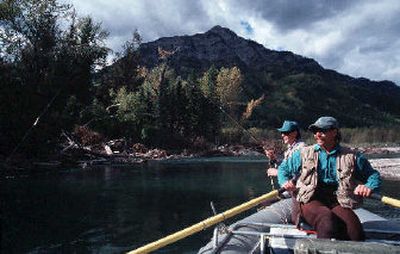B.C. rivers are coming prime for anglers

A new daily fishing fee could reduce the crowds of anglers that have been flocking to southeastern British Columbia rivers, some of which are coming into good fishing condition.
The St. Mary River was high and rolling fast when the rivers were opened to fishing June 15, but that and the Skookumchuk both were in good shape for fly fishing in the past two weeks.
The Elk and other prime trout rivers in the East Kootenay region have been plagued with high water from frequent rainstorms.
Kelly Laatsch, operator of the St. Mary Fly Shop at Kimberley, listed the following among the most popular East Kootenai region trout streams:
•Elk River, “arguably one of the finest cutthroat rivers in North America.”
•Upper Wigwam, home to the “largest population of bull trout in North America.”
•St. Mary, as an ideal stream to fish for big cutthroat and bull trout.
•Upper Skookumchuck, “one of the few wilderness rivers in the East Kootenay that produces fantastic cutthroat fishing.”
Laatsch noted that seven streams and their tributaries are now Class 11 waters, meaning nonresident anglers will have to buy a special $20-a-day license, as well as a standard license, to fish them. The streams include the Elk, St. Mary, Wigwam, Skukumchuck, Bull, Kootenay upstream of the White River and the White.
The Elk, which originates at Elk Lake Park, has nearly 70 miles of accessible water, he said.
“It’s a breathtaking, beautiful river and it’s an easy river to float. But I’ll tell you a guide secret: Don’t fish the Elk until September. In September and October you can have the river to yourself. You’ll have exceptional fishing and you won’t see many other fishermen.
“Most fishermen fish below Sparwood. The Hosmer-to-Fernie stretch is the most heavily fished water on the river.”
The boat traffic is so dense along the lower river, he said, that the fish move to within 10 feet of the shorelines to avoid the traffic.
“Most anglers fish the fast, rainbow-type water. Experienced fishers know that the best cutthroat fishing is in the slow, clear water away from the traffic.”
Furthermore, he noted, the only reason to resort to streamers is to catch bull trout, which are plentiful but don’t fight as hard as the cutthroat. Most fly fishers quickly decide to go back to cutthroat fishing after they’ve caught a bull trout or two.
“Cutthroat spend most of their feeding time looking up. That’s why guides recommend using dry flies all the time. There’s no reason to use nymphs or patterns under the surface unless you want to catch bull trout.
“Fishers don’t have to wait for a hatch. Cutthroat will rise to a dry fly at any time of the day. It’s a matter of being persistent.”
The St. Mary River “is a great cutthroat and bull trout fishery, Laatsch said. It’s one of the few rivers that’s usually clear enough to fish by mid-June.
Anglers who want to get away from other fishermen for a few days fish the upper river, especially in the Purcell Wilderness, he said. To get there, though an angler must drive about 35 miles up a gravel road.
“Don’t try to float the upper section. It’s blocked by some really nasty log jams and you’ll have to get your pontoon boat over or around one jam after another.”
The stretch from a few miles above St. Mary Lake, a wide spot along the river, to the middle section is an exceptional area to fish, Laatsch said. “It has lots of gravel bars and it doesn’t get floated much.”
Most guides fish the canyon area, he said. It’s big water and has good fish populations. However, the canyon can get hot in the summer, the temperature sometimes rising to 110 degrees.
The section below the golf course, he said, produces excellent fishing, but wading fishers should be careful. The rocks are extremely slick and greasy.
Laatsch said the cuttbow (cross between a rainbow and cutthroat) population seems to be increasing. The cuttbows are exceptionally wild, hard-fighting fish.
The Wigwam, which originates as a tiny stream in Montana, always has had the reputation as home to outsize cutthroat, but it’s becoming better known as a producer of huge bull trout, according to Laatsch. Several guides have been taking fly fishers into the upper section to try to catch a world record fish on 4- to 6-pound-test line.
Last year a fly fisher caught a bull trout that was within 3 ounces of the world record for a 4-pound-test line, he said. This year a new world record could be caught.
The Wigwam’s bull trout population has been increasing dramatically. Only 200 redds were counted in 1996; last year the count topped 1,500.
“The Wigwam is a beautiful little stream to fish,” he said. “An angler can sneak up to holes and catch huge cutthroat. But it’s a difficult hike to get into the upper river.”
Even more difficult is the three-mile hike into the canyon area of the Skookumchuck, he said.
“It’s tough slogging for about two miles to get to the river. Then we hike downstream to kilometer mark 37 before we start fishing. The canyon is narrow and casting is tricky in many places, but the fishing for big, unwary cutthroat is outstanding.”
There’s good fishing below the canyon, he said, but not nearly as good as the fishing in the tree-surrounded river in the often-shaded canyon.